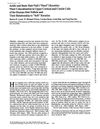TLDR Mouse nails are similar to human nails, making them useful for studying nail diseases.
The study compared the human and mouse nail units to assess their suitability for studying nail diseases. Both species shared major structures such as the proximal nail fold, cuticle, nail matrix, nail bed, nail plate, and hyponychium, with differences in nail shape and an extended hyponychium in mice. Keratin expression patterns were largely similar between the two. These findings suggested that the mouse nail unit closely resembled the human nail unit, making it a valuable model for investigating nail diseases and biology.
38 citations
,
December 2006 in “Journal of Investigative Dermatology” Keratin patterns in hair follicles help understand hair growth and potential hair and nail disorders.
58 citations
,
November 2004 in “The journal of investigative dermatology/Journal of investigative dermatology” The Foxn1 gene is essential for normal nail and hair development.
110 citations
,
August 2004 in “British Journal of Dermatology” The ventral matrix is the main source of the nail plate.
31 citations
,
April 2004 in “Journal of Investigative Dermatology” 60 citations
,
December 2003 in “Journal of Investigative Dermatology” 101 citations
,
August 2001 in “The Journal of Cell Biology” A new keratin 6 type in mice explains why some mice without certain keratin genes still have normal hair and nails.
 28 citations
,
August 2001 in “Journal of cutaneous medicine and surgery”
28 citations
,
August 2001 in “Journal of cutaneous medicine and surgery” People with Down's syndrome often have more skin problems due to a weak immune system.
88 citations
,
June 2000 in “Journal of Investigative Dermatology” 119 citations
,
January 2000 in “British Journal of Dermatology” 318 citations
,
October 1998 in “The Journal of Cell Biology”  356 citations
,
December 1986 in “The journal of cell biology/The Journal of cell biology”
356 citations
,
December 1986 in “The journal of cell biology/The Journal of cell biology” Hair and nail cells share similar proteins, indicating a common differentiation pathway.

